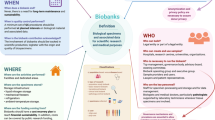Abstract
The success of molecular research and its applications in both the clinical and basic research arenas is strongly dependent on the collection, handling, storage, and quality control of fresh human tissue samples. This tissue bank was set up to bank fresh surgically obtained human tissue using a Clinical Annotated Tissue Database (CATD) in order to capture the associated patient clinical data and demographics using a one way patient encryption scheme to protect patient identification. In this study, we determined that high quality of tissue samples is imperative for both genomic and proteomic molecular research. This paper also contains a brief compilation of the literature involved in the patient ethics, patient informed consent, patient de-identification, tissue collection, processing, and storage as well as basic molecular research generated from the tissue bank using good clinical practices. The current applicable rules, regulations, and guidelines for handling human tissues are briefly discussed. More than 6,610 cancer patients have been consented (97% of those that were contacted by the consenter) and 16,800 tissue specimens have been banked from these patients in 9 years. All samples collected in the bank were QC’d by a pathologist. Approximately 1,550 tissue samples have been requested for use in basic, clinical, and/or biomarker cancer research studies. Each tissue aliquot removed from the bank for a research study were evaluated by a second H&E, if the samples passed the QC, they were submitted for genomic and proteomic molecular analysis/study. Approximately 75% of samples evaluated were of high histologic quality and used for research studies. Since 2003, we changed the patient informed consent to allow the tissue bank to gather more patient clinical follow-up information. Ninety two percent of the patients (1,865 patients) signed the new informed consent form and agreed to be re-contacted for follow-up information on their disease state. In addition, eighty five percent of patients (1,584) agreed to be re-contacted to provide a biological fluid sample to be used for biomarker research.





Similar content being viewed by others
Abbreviations
- CATD:
-
Clinical Annotated Tissue Database
- QC:
-
Quality control
- IU:
-
Indiana University
- H&E:
-
Hematoxylin & Eosin
References
Bateman A, Theaker J, Howell W (1996) Whose tissue is it anyway? J Pathol 179:229–231
Bauer K, Taub S, Parsi K (2004) Ethical issues in tissue banking for research: a brief review of existing organizational policies. Theor Med Bioeth 25(2):113–142
Carrier R (2004) The case for regulatory compliance of electronic medical records about human tissue intended for transplantation. J Healthc Inf Manag 18(4):61–66
Ebert BL, Golub TR (2004) Genomic approaches to hematologic malignancies. Blood 104(4):923–932
Farkas D et al (1996) Specimen collection and storage for diagnostic molecular pathology investigation. Arch Pathol Lab Med 120:591–596
Gajiwala AL (2003) Setting up a tissue bank in india: the tata memorial hospital experience. Cell Tissue Bank 4(2–4):193–201
Goodman JL (2004) The safety and availability of blood and tissues–progress and challenges. N Engl J Med 351(8):819–822
Grody W (1995) Molecular pathology, informed consent, and the paraffin block. Diagn Mol Pathol 4:155–157
Haimowitz M (1997) Practical issues in tissue banking. Am J Clin Pathol 107(suppl 1):S75–S81
Hulette CM (2003) Brain banking in the United States. J Neuropathol Exp Neurol 62(7):715–722
Ilyin SE, Belkowski SM, Plata-Salaman CR (2004) Biomarker discovery and validation: technologies and integrative approaches. Trends Biotechnol 22(8):411–416
Jewell SD et al (2002) Analysis of the molecular quality of human tissues: an experience from the Cooperative Human Tissue Network. Am J Clin Pathol 118(5):733–741
Lesko LJ et al (2003) Pharmacogenetics and pharmacogenomics in drug development and regulatory decision making: report of the first FDA-PWG-PhRMA-druSafe workshop. J Clin Pharmacol 43(4):342–358
LiVolsi VA et al (1993) The cooperative human tissue network. an update. Cancer 71(4):1391–1394
Maschke KJ, Murray TH (2004) Ethical issues in tissue banking for research: the prospects and pitfalls of setting international standards. Theor Med Bioeth 25(2):143–155
Mills S, Kempson R, Fechnere ReA (1995) Guardians of the wax.... and the patient. Mod Pathol 8:699–700
Naber S (1996) Continuing role of a frozen-tissue bank in molecular pathology. Diagn Mol Pathol 5:253–259
Oosterhuis JW, Coebergh JW, van Veen EB (2003) Tumour banks: well-guarded treasures in the interest of patients. Nat Rev Cancer 3(1):73–77
Orr S et al (2002) The establishment of a network of European human research tissue banks. Cell Tissue Bank 3(2):133–137
Qualman SJ et al (2004) Establishing a tumour bank: banking, informatics and ethics. Br J Cancer 90(6):1115–1119
Sandusky G et al. (2006) Quality control of human tissues: experience from the Indiana University-Lilly Research Labs Tissue Bank. Amer Assn Can Res 2006 Mtg
Spruessel A et al (2004) Tissue ischemia time affects gene and protein expression patterns within minutes following surgical tumor excision. Biotechniques 36(6):1030–1037
Author information
Authors and Affiliations
Corresponding author
Rights and permissions
About this article
Cite this article
Sandusky, G.E., Teheny, K.H., Esterman, M. et al. Quality control of human tissues-experience from the Indiana University Cancer Center-Lilly Research Labs human tissue bank. Cell Tissue Banking 8, 287–295 (2007). https://doi.org/10.1007/s10561-007-9037-0
Received:
Accepted:
Published:
Issue Date:
DOI: https://doi.org/10.1007/s10561-007-9037-0




